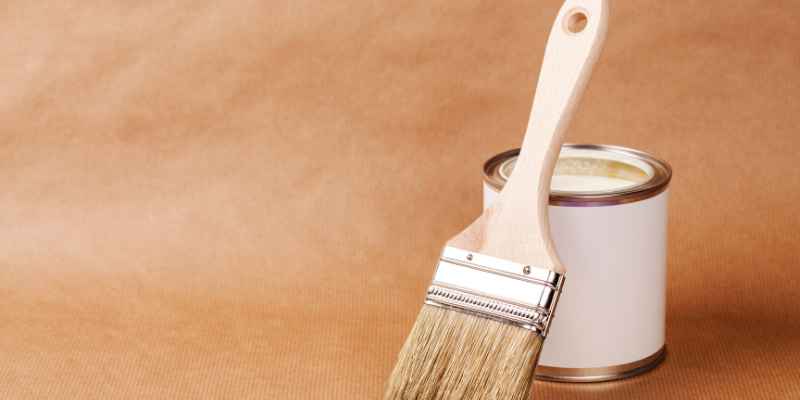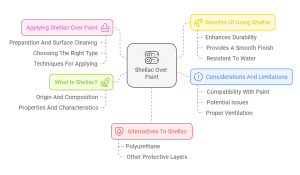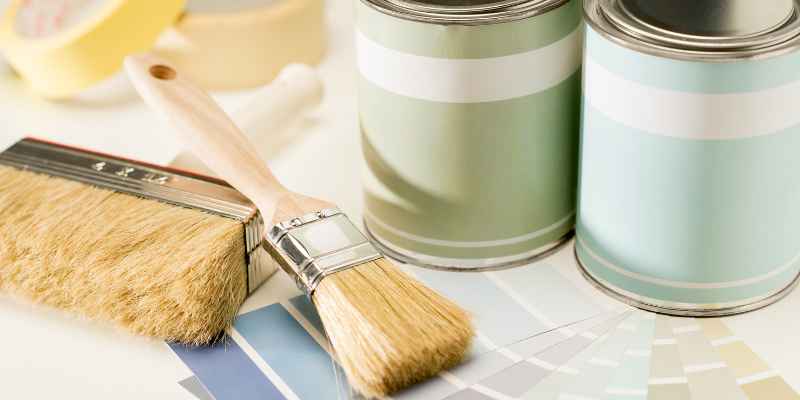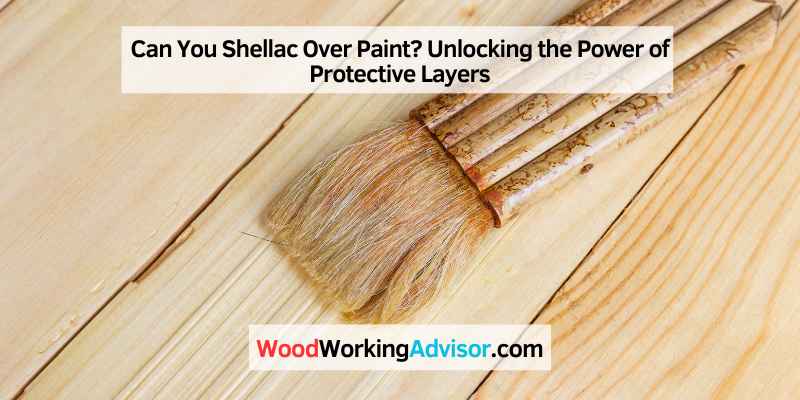Yes, you can shellac over paint to provide a protective and glossy finish. Shellac acts as a clear topcoat that enhances the durability and aesthetic appeal of the painted surface.
This process is commonly used in furniture refinishing or as a final touch for DIY projects. By applying a thin and even layer of shellac over a fully dried painted surface, you can achieve a smooth and polished look. Keep in mind that proper surface preparation, using the appropriate shellac application technique, and allowing sufficient drying time between coatings are essential for a successful outcome.
What Is Shellac?
Shellac is a versatile and popular finishing material that has been used for centuries to protect and beautify various surfaces. It is derived from the resinous secretion of the female lac bug, which is native to the forests of India and Thailand. The lac bug secretes a sticky substance that hardens into a protective shell around the eggs. This shell is carefully harvested and refined to produce shellac.
The Origin And Composition Of Shellac
Shellac has a rich history that dates back thousands of years. The use of shellac can be traced back to ancient times, where it was used in the production of jewelry, decorative items, and even as a pigment for artwork. In the 18th century, shellac gained widespread popularity as a wood finishing material, particularly in the furniture industry.
Shellac is composed mainly of two components: the resin (shellac resin) and the wax. The resin is the primary component responsible for the protective and adhesive properties of shellac, while the wax helps to enhance its durability and sheen.
The resin is harvested by scraping the lac bugs’ secretions off tree branches. The scraped resin is then processed to remove impurities and is often sold in the form of flakes or buttons. These flakes or buttons are further processed into a liquid form by dissolving them in denatured alcohol to create shellac.
Properties And Characteristics Of Shellac
Shellac possesses a unique set of properties that make it an ideal finishing material for a wide range of applications. Here are some key characteristics of shellac:
- Adhesive: Shellac has excellent adhesive properties, allowing it to bond well with various surfaces, including wood, metal, and plastic.
- Water resistance: While not completely waterproof, shellac has good resistance to water, making it suitable for use in areas with occasional exposure to moisture.
- Quick drying: Shellac dries relatively quickly, allowing for multiple coats to be applied in a short amount of time.
- High gloss finish: Shellac produces a glossy finish that enhances the natural beauty of the underlying material. It can also be buffed to a satin or matte finish if desired.
- Easy to repair: Shellac is known for its easy repairability. Damaged areas can be easily touched up or re-coated without the need for extensive sanding or stripping.
Additionally, shellac offers good heat resistance and is resistant to many chemicals, making it suitable for use in a variety of environments.
In conclusion, shellac is an ancient and versatile finishing material that has stood the test of time. Its origin, composition, and unique properties make it a popular choice for a variety of applications. Whether you are a woodworking enthusiast or a DIY enthusiast, shellac can provide a beautiful and durable finish to your project.

Applying Shellac Over Paint
When it comes to refinishing furniture or giving a fresh look to your walls, you may often find yourself wondering if you can shellac over paint. The good news is that shellac can be a great way to add a protective layer and enhance the durability of your painted surfaces. In this blog post, we will discuss the process of applying shellac over paint, including the necessary preparation steps, choosing the right type of shellac, and various application techniques.
Preparation And Surface Cleaning
Before applying shellac over paint, it is crucial to prepare the surface properly. This will ensure better adhesion and a smoother finish. Here are the essential steps for preparation and surface cleaning:
- Start by wiping down the painted surface with a clean, lint-free cloth to remove any dust or debris.
- Inspect the surface for any imperfections or rough spots. Sand them gently with fine-grit sandpaper to create a smooth surface.
- Fill in any cracks, holes, or deep scratches with a suitable wood filler or spackle. Allow it to dry and then sand it smooth.
- Thoroughly clean the surface with a mild detergent and water solution to remove any dirt, grease, or grime. Rinse it well and let it dry completely.
Choosing The Right Type Of Shellac
When it comes to selecting the right type of shellac, there are a few options to consider. Shellac is available in different finishes, such as clear, amber, or tinted. Additionally, you can choose between premixed shellac or flakes that you can dissolve in denatured alcohol. The type of shellac you choose depends on your desired finish and the level of protection you want to achieve. Here’s how you can choose the right shellac:
- Determine the desired finish for your project. Clear shellac provides a transparent and natural appearance, while amber or tinted shellac can add warmth and depth.
- If using flakes, follow the manufacturer’s instructions to dissolve them in denatured alcohol to create your own shellac mixture. This allows you to customize the strength and color.
- Consider the level of protection needed. If you want maximum durability, opt for a higher concentration of shellac.
Techniques For Applying Shellac Over Paint
When it comes to applying shellac over paint, different techniques can be used depending on the surface and the desired outcome. Here are some techniques to consider:
- Brush Application: Using a quality brush or foam applicator, apply a thin and even coat of shellac in the direction of the grain for best results. Avoid over-applying as it can lead to drips or uneven drying.
- Spray Application: If you have experience with spray equipment, you can achieve a professional finish by spraying shellac over the painted surface. Ensure proper ventilation and follow the manufacturer’s instructions for the spraying technique.
- Padding: Padding involves using a clean cloth or pad to apply shellac in a gentle rubbing motion. This technique is suitable for smaller surfaces or intricate details.
In conclusion, applying shellac over paint can be a great way to protect and enhance the durability of your painted surfaces. By following the preparation steps, choosing the right type of shellac, and using suitable application techniques, you can achieve a beautiful and long-lasting finish. Remember to always test a small, inconspicuous area before applying shellac to the entire surface to ensure compatibility and desired results.

Benefits Of Using Shellac As A Protective Layer
Shellac is an effective protective layer that can be applied over painted surfaces. It enhances durability, provides a glossy finish, and adds an extra layer of protection against scratches and stains.
Shellac is a versatile and popular choice for protecting painted surfaces, offering several key benefits that make it a top choice for homeowners and professionals alike. When it comes to enhancing durability and longevity, providing a smooth and glossy finish, as well as being resistant to water and stains, shellac truly excels. Let’s take a closer look at each of these benefits.
Enhances Durability And Longevity
Shellac acts as a barrier between the painted surface and the outside world, effectively protecting it from wear and tear. This protective layer enhances the paint’s ability to withstand daily use, ensuring it maintains its vibrant color and pristine appearance for an extended period. By preventing moisture, dirt, and dust from penetrating the surface, shellac helps to prevent chipping, peeling, and fading of the paint over time.
Provides A Smooth And Glossy Finish
One of the standout features of shellac is its ability to provide a smooth and glossy finish. When applied over paint, shellac creates a lustrous sheen that enhances the overall aesthetic appeal of the surface. This glossy finish adds depth and richness to the color, making it appear more vibrant and captivating. Additionally, the smoothness of shellac creates a velvety texture that feels pleasing to the touch, adding a tactile element to the painted surface.
Resistant To Water And Stains
Another significant advantage of using shellac as a protective layer is its excellent resistance to water and stains. When spills or accidents occur, shellac acts as a barrier, preventing liquids from seeping into the paint and causing stains or discoloration. This makes it particularly suitable for surfaces that are prone to exposure, such as kitchen cabinets or bathroom walls. With shellac in place, you can have peace of mind knowing that your painted surfaces are well-protected against potential water damage and unsightly stains.
In conclusion, shellac offers a range of benefits when used as a protective layer over paint. It enhances durability and longevity, provides a smooth and glossy finish, and is resistant to water and stains. This makes it an ideal choice for anyone looking to preserve the beauty and integrity of their painted surfaces. Whether you’re a DIY enthusiast or a professional painter, shellac can take your paint job to the next level.
Considerations And Limitations
Shellacking over paint requires careful consideration and has limitations. While it is possible, proper surface preparation is crucial to ensure adhesion and longevity of the shellac finish. Consult a professional or conduct thorough research to understand the specific requirements for successful shellacking over painted surfaces.
Compatibility With Different Types Of Paint
Can you shellac over paint? It’s a question that many people ask when considering how to protect and enhance their painted surfaces. When it comes to compatibility, shellac can be applied over various types of paint, including latex, acrylic, and oil-based paints. However, it is important to note that shellac may not adhere well to certain types of paints, such as glossy or high-sheen finishes. In such cases, proper surface preparation and testing are essential to ensure a successful application. It’s a good idea to consult the paint manufacturer’s recommendations or seek professional advice before proceeding further.
Potential Issues And Challenges
While shellac can be a versatile and effective coating for painted surfaces, there are potential issues and challenges to consider. One common issue is the risk of shellac melting or softening when exposed to certain solvents or chemicals. This can result in the paint peeling or bubbling, compromising the overall finish. It is important to be cautious when cleaning or treating shellac-coated surfaces to avoid using harsh chemicals or abrasive cleaners that can damage or dissolve the shellac. Additionally, it’s worth noting that shellac is not as durable as other protective coatings, so it may not be suitable for high-traffic areas or surfaces that will be subjected to excessive wear and tear over time.
Proper Ventilation And Safety Precautions
When considering shellacking over paint, it is crucial to prioritize proper ventilation and safety precautions. Shellac is a solvent-based coating that can emit strong fumes during application and drying. Adequate ventilation is necessary to ensure that these fumes are properly dispersed and not inhaled excessively. Before starting the project, ensure that the work area is well-ventilated, either by opening windows or using exhaust fans. It is also important to wear appropriate personal protective equipment, such as goggles and a mask, to minimize exposure to fumes and particles. Lastly, always read and follow the safety instructions provided by the shellac manufacturer to ensure a safe and successful application process.

Alternatives To Shellac For Protective Coating
Looking for alternatives to shellac for protective coating? Discover if you can shellac over paint to enhance the durability and longevity of your surfaces. Explore the options to find the best solution for your specific needs.
When it comes to finding a protective coating for your painted surfaces, shellac is a popular choice. However, there are other alternatives that can provide excellent protection while offering different benefits. In this article, we will explore some of the alternatives to shellac and how they can serve as effective protective layers. Read on to discover more!
Polyurethane As A Popular Alternative
One of the most popular alternatives to shellac is polyurethane. This versatile protective coating is known for its durability and resistance to wear and tear. Polyurethane creates a hard, clear finish that adds a glossy sheen to your painted surfaces. It provides excellent protection against water, chemicals, and scratches, making it an ideal choice for high-traffic areas like floors and tabletops.
Polyurethane is available in both oil-based and water-based formulations. While the oil-based option offers greater durability, it may also give a slight amber tone to light-colored paints. On the other hand, water-based polyurethane dries faster, has minimal odor, and maintains the original color of the paint. Choose the one that best suits your needs and preferences.
Other Types Of Protective Layers
In addition to polyurethane, there are other types of protective layers that can serve as alternatives to shellac. These include:
- Epoxy: This strong and durable coating is commonly used on concrete and metal surfaces. It provides excellent resistance against chemicals, abrasions, and impacts, making it suitable for industrial settings.
- Lacquer: Similar to shellac, lacquer forms a hard, glossy finish that offers protection against moisture and wear. It is often used on wood surfaces and can provide a beautiful, traditional look.
- Varnish: Varnish is a clear or tinted coating that enhances the natural beauty of wood while protecting it from scratches, UV rays, and water damage. It is commonly used on furniture, cabinetry, and wooden floors.
Each of these alternatives has its own unique properties, so consider the specific requirements of your project before making a decision. Whether you opt for polyurethane, epoxy, lacquer, or varnish, you can be confident that your painted surfaces will receive the protection they need to withstand daily wear and tear.
Conclusion
To conclude, shellacking over paint is indeed possible. It serves as an effective way to protect the painted surface while adding a glossy finish. By following proper preparation techniques and using quality products, you can achieve a durable and beautiful result.
Whether you want to revitalize a piece of furniture or enhance the longevity of a painted surface, shellacking can provide an excellent solution. So don’t hesitate to explore this method and add a touch of elegance to your projects.

